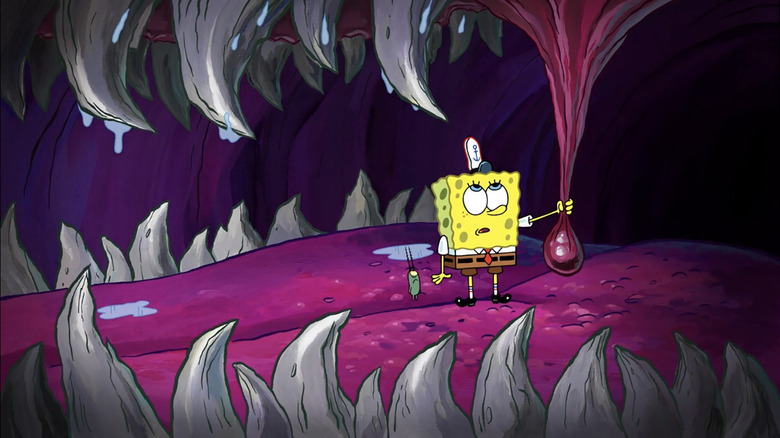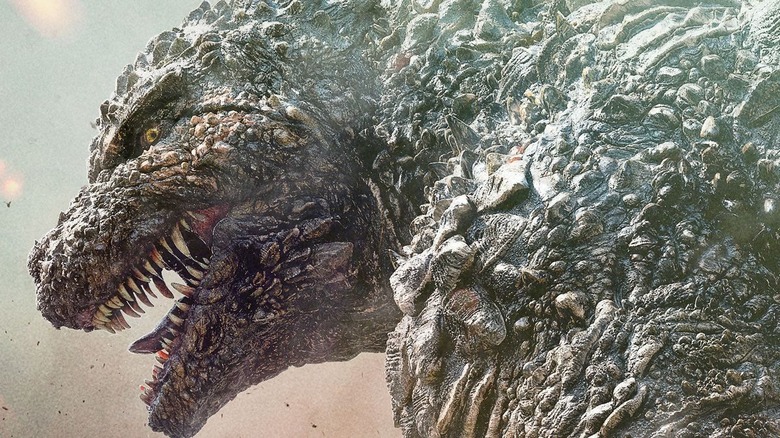Godzilla And SpongeBob Have One Big Thing In Common
At the start of every episode of "SpongeBob SquarePants," Painty the Pirate appears to start the theme song. After his now iconic "ARE YA READY, KIDS?!" warm-up, the show cuts to the image of a small island in the middle of the sea, before shifting down into the animated world of our titular, porous hero. The island is Bikini Atoll, a small part of the Marshall Islands in the Pacific island chain that became a bargaining chip between countries throughout the early 20th century. After World War II, the United States captured the land and forced out some 40 families residing on the island with promises of a return that became impossible. The area was instead turned into a nuclear weapons test site and, in the weirdest ways imaginable, became embedded in pop culture.
French clothing designer Louis Réard debuted the bikini swimsuit four days after the first public test of a nuclear bomb on the island (violating the Marshall Islanders' customs of modesty in the process), so yes, that does mean whenever you buy a bikini for the summer, you're purchasing a garment named after nuclear weapons testing. This is also what provided the name of SpongeBob SquarePants' hometown. The average child probably thinks "Bikini Bottom" is just a cute play on the swimsuit — which it is — but it's also a darkly comedic acknowledgment of how nuclear testing impacted wildlife. The real Bikini Atoll, for example, has giant, radioactive crabs scuttling about ... although we have yet to conduct scientific studies on whether or not they're also cheapskates who skirt labor laws.
However, SpongeBob SquarePants and the residents of Bikini Bottom are not the only massively popular fictional creatures to come out as a result of this real-life horror. There's also Godzilla.
Rise for your radioactive kaiju lizard monster king
The origin, cause, and canon of Godzilla has changed many times over the last 70 years, but Ishiro Honda's "Gojira" in 1954 was created as a direct result of the American nuclear bomb test in the Bikini Atoll. Godzilla was a creature mutated in the aftermath of the fallout, and his destruction was a reflection of the devastation caused by the American atomic bombings of Hiroshima and Nagasaki. The most recent Japanese "Godzilla" film (as opposed to the American MonsterVerse), "Godzilla Mins One," is not just the only "Godzilla" film to win an Academy Award, but it's also one of the best "Godzilla" films ever made. The film takes place in the immediate wake of the war, with Japan still reeling from the bombings, and now they've got this radioactive monster to deal with too. Many "Godzilla" films have either directly shown or digitally recreated the footage of the actual nuclear test, including "Minus One."
Similarly, "SpongeBob SquarePants" has done the same. One of the most memorable examples is the "Dying for Pie" episode where Squidward believes SpongeBob accidentally ate a pie filled with a bomb, but when it's revealed that SpongeBob didn't eat the pie, he trips and drops the pie, which explodes all of Bikini Bottom and the water above. Like this scene, "SpongeBob" episodes show a cartoon explosion underwater before cutting to live-action footage of the Baker bomb tests at Bikini Atoll. Perhaps in a darkly comedic bit of revisionist history, it was SpongeBob's pie that birthed Godzilla and not atomic power. After all, Godzilla is a canonical being that exists just outside of Bikini Bottom.
Delivery to Monster Island
In a recent season 13 episode released in 2023, "Delivery to Monster Island," SpongeBob and the villainous Plankton are blown by a strong wind and wind up in a place called Monster Island. There are plenty of classic hijinks, like making a shelter in a cave that turns out to be the mouth of another monster or finding a banana on the island for food that turns out to just be a banana monster. Any food consumed on the real Bikini Atoll has to be shipped in because the ecosystem is radioactive and therefore unfit for consumption (although, fortunately, there have been no reports of banana monsters). SpongeBob and Plankton eventually started a new restaurant called the Coco-Hut and sold coconut patties to the monsters, which, for the most part, just looked like random cartoon creatures.
But then the head of Shin Godzilla makes a cameo, finally confirming that the King of the Monsters and SpongeBob SquarePants are underwater neighbors. It's eventually revealed that the island is just the shell of a giant sea turtle monster (Gamera, anyone?), yet the Shin Godzilla head appears alongside a bunch of other kaiju from the "Godzilla" universe. There's a bat that looks a whole lot like Bagorah, a gator-looking Manda the sea dragon, and two others who could be a handful of different oversized reptiles. SpongeBob has previously done battle with a number of other non-Godzilla monsters, so does this mean the Alaskan Bull Worm is also canonically a part of the MonsterVerse?
It's a fun thought experiment to be sure — one that's made immediately bleak by the realization that the only reason these two iconic characters exist in the same world is the result of Americans setting off nuclear bombs.


